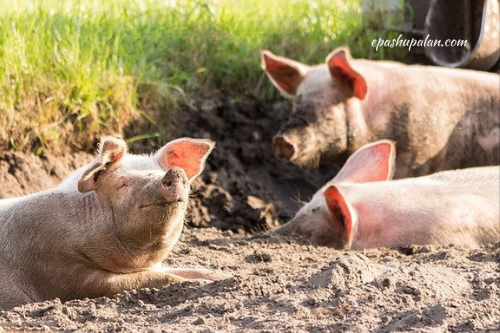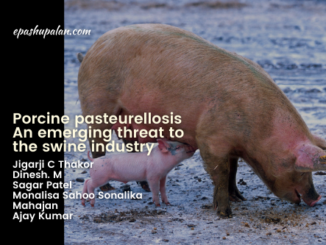Introduction
India with its fast growing population faces huge challenge regarding increasing demand of livestock products and food security. This challenge can be overcome by an integrated approach in livestock farming. Piggery is very well suited for integrated farming and complements to intensive crop production. It not only provides meat as a source of cheap and healthy protein but also provides bristles and manure. Pig rearing offers employment opportunities to seasonal farmers belonging to lowest socio economic strata to supplement their income. It is also popular among the tribal and backward farmers especially of the north eastern states. However, these farmers have fewer resources to undertake scientific pig farming with improved housing, feeding and other managemental practices.
Pig population in India is estimated around 9.06 million and constitutes 1.69% of the total livestock population (20th livestock census). However, among various livestock species pig rearing is advantageous due to following reasons:
- High feed conversion efficiency.
- Ability to utilize variety of feed stuffs and convert them into valuable pork.
- High prolificacy with short generation interval.
- Requirement of less investment and infrastructure.
- High meat yield with dressing percentage of around 65-80%
- Great demand of bristles, manure, pork and other products obtained from pig.
- Early return in terms of profit.
Keeping in view the importance of pig farming and tremendous potential that lies in improvement of pig production, scientific aspects of management have been discussed in this article under various headings.

Selection and Breeding Management of Pig
Currently there are 10 registered pig breeds in India namely Ghoongroo, Niang Megha, Agonda Goan, Tenyi Vo, Nicobari, Doom, Zovawk, Ghurrah, Mali and Purnea. Several crossbred pigs have also been developed and are found to be more suitable due to their faster growth rate, disease resistance and quality meat. Selection of breed is mainly based on consumer preference and growth rate along with various other factors. It is followed by breeding which is carried out indiscriminately in indigenous pigs under scavenging system. This limits their production efficiency and even makes them prone to diseases. Domesticated sows are non seasonal and polyestrous with estrus cycle of around 21 days. Estrus detection is crucial for successful breeding and requires observant technicians with complete understanding of female cyclic behavior. Signs of estrus include loss of appetite, restlessness, increased vocalization, erect ears, alert attitude, reddened and swollen vulva, frequent urination, lordosis, rigidity in response to back pressure (standing reflex) etc. It is always advised to breed healthy sows during or after third estrus. There are broadly two types of mating system in pigs- Natural and Artificial. Natural mating includes hand mating and pen mating. In hand mating boar is taken to sow and each service is supervised whereas in pen mating boar is allowed to remain with the sow herd. Another mating system known as artificial insemination involves deposition of semen in female reproductive tract. The best time for AI is 15-24 hours after onset of estrus in non slippery surface.
Care during Gestation, Farrowing and Lactation
Proper care of sows during gestation, farrowing and lactation is of utmost importance in order to produce large litter of healthy piglets. Care provided during this critical period prepares the sow for next cycle of weaning and breeding.
Gestation
This stage may seem the simplest among other stages of pig production cycle. However, proper management and nutrition may greatly affect the productivity of current as well as upcoming generation.
- After insemination the sows should be placed in individual crates until pregnancy is confirmed. Following this they should be placed in loose pens.
- The loose pens have found to be beneficial in maintaining the muscle tone of sows and enables efficient calcium metabolism. Pens should be dry and well ventilated.
- In order to allow equal access to food they should be grouped according to weight.
- Feed levels can be increased depending on the body weight of sow. During late gestation diet containing soluble fiber must be provided to keep the sow calm and to increase colostrum production.
- Free access to water and sufficient drinkers should be made available to the pregnant sow.
Farrowing
- The Sow should be dewormed two weeks prior to farrowing. Also, external parasite infestation should be treated well in advance.
- The farrowing unit should be disinfected using quaternary ammonium compounds, iodoform compounds, lye etc. at least a week before the expected farrowing date.
- Before placing the sows in farrowing pen the teats and udder should be washed using mild soap and water.
- The sow should be placed in farrowing pen well in advance after bedding the pen properly using straw.
- The farrowing pen should be clean, dry and well ventilated.
- Prior to farrowing, the ration given to the sow should be reduced to 50% and laxatives such as wheat bran should be added.
- Closely monitor the sow during farrowing and care should be taken in order to combat any complications.
- As soon as the piglets are born, they should be wiped using clean towel and navel cord should be carefully ligated and disinfected using tincture of iodine.
- Allow piglets to suckle immediately for next 30 minutes under supervision and aid the smaller piglets.
- The piglets should be protected using guard rails and should be kept far from the nervous sow.
- Dead piglets along with the placenta should be disposed immediately with utmost care.
- Vaccination should be done as per the vaccination schedule and needle teeth should be clipped carefully after birth.
- As sow milk is deficient in iron therefore to prevent piglet anemia iron supplementation should be done.
Lactation
Providing piglets with sufficient amount of sow’s milk ensures their viability. Therefore, management of lactating sow is crucial.
- Sow milk is more concentrated than cow milk and therefore requires more feed. 1.5 Kg of feed is provided to the sow with an additional amount of 0.5 Kg/ piglet (maximum feed up to 5-6 Kg).
- Plenty of succulent feed and Lucerne hay should be provided during suckling period.
- Sufficient water should be provided to the sows in order to meet the growing demand of milk production. In general, 2.5 liters of water is required to produce 1 liter of milk.
- Prior to weaning, feed is restricted in order to restrict milk flow and dry the udder.
- Amino acid balance, calcium: phosphorus, electrolyte balance and vitamin- minerals should be optimized.
- Creep feed should be provided to piglets from 5th day in order to make them familiar with feed and to ensure adequate nutrient intake.
Miscellaneous
Apart from nutrition and management of pigs during different stages, various management practices are followed in the herd in order to increase the profit gained from the farm. These include:
- Identification of individual pigs using ear tags, tattooing, ear notching etc.
- Quarantine of newly introduced animals to the herd
- Culling unproductive animals
- Record keeping in farm with special attention to pedigree recording
- Castration of piglets
- Timely segregation and treatment of diseased animals
| The content of the articles are accurate and true to the best of the author’s knowledge. It is not meant to substitute for diagnosis, prognosis, treatment, prescription, or formal and individualized advice from a veterinary medical professional. Animals exhibiting signs and symptoms of distress should be seen by a veterinarian immediately. |






Be the first to comment